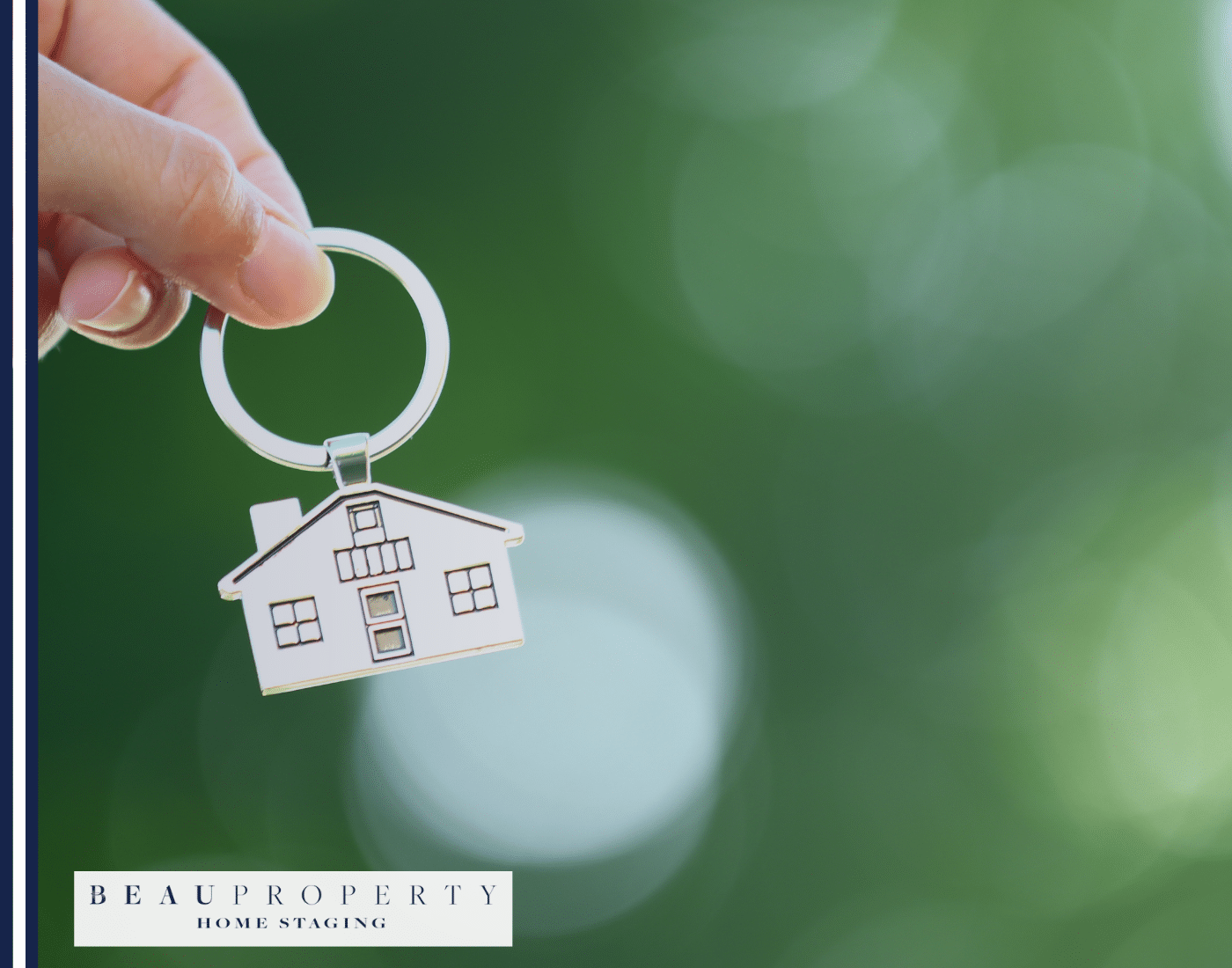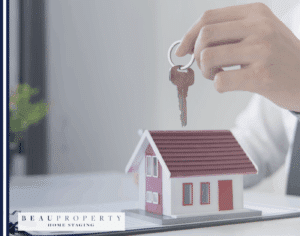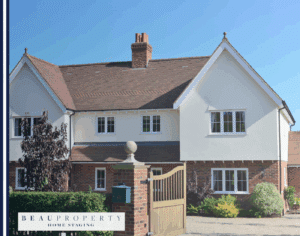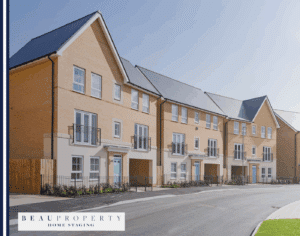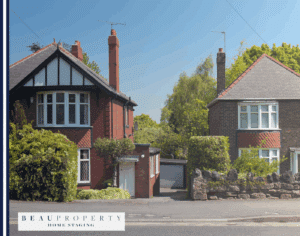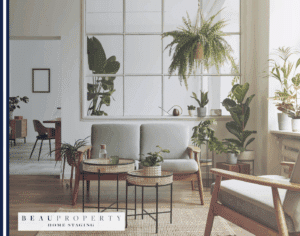Introduction: The Power of First Impressions in Property Sales
The Critical Importance of First Impressions in Property Sales
First impressions play a crucial role in property sales. Research indicates that potential buyers form judgements within 38 seconds of viewing a home. This snap decision can significantly influence their perceptions of value and affect their willingness to make an offer.
How Poor First Impressions Can Significantly Reduce Property Value and Offers
Poor first impressions, often stemming from cluttered spaces, outdated decor, or untidy exteriors, can have adverse impacts. Properties that fail to captivate buyers in the initial moments frequently see reduced offers and lower overall sale prices. In some cases, this can lead to price reductions of up to 20% as sellers seek to entice interest in a less appealing home.
Overview of How Home Staging Addresses These Challenges and Delivers Measurable Returns
Home staging offers an effective solution to combat poor first impressions by enhancing the visual appeal and functionality of a property. Professional staging transforms spaces to be inviting and aesthetically pleasing, using techniques such as strategic furniture placement, neutral colour schemes, and improved lighting. This not only elevates the home’s appeal but has been proven to deliver measurable returns, including faster sales and higher offers. On average, staged homes have an ROI of 8-10% on the sale price, providing a compelling case for sellers considering this investment.
This careful attention to first impressions can make the difference between a lingering listing and a swift, lucrative sale.
Understanding Home Staging in the UK Property Market
Definition and Purpose of Professional Home Staging for UK Properties
Home staging is the strategic preparation of a property for sale by enhancing its appeal to potential buyers. This involves careful planning and execution of interior design elements to highlight the home’s strongest features while creating a neutral, inviting atmosphere. The purpose of home staging is not merely decorating; it is about making the property more attractive to a wider audience, enabling prospective buyers to visualise how they could live in the space.
By setting the stage for a desirable living environment, home staging helps a property stand out in a competitive market. This can significantly shorten the time a property spends on the market while often achieving higher sale prices. According to the Home Staging Association UK (HSAUK), professional staging can create the optimal environment for buyers, promoting faster decisions and better offers.
Current Adoption Trends Among UK Property Sellers and Estate Agents
Home staging is becoming an increasingly common practice among UK property sellers and estate agents. The growing awareness of its benefits has led to more sellers investing in professional staging services. In a report by the Home Staging Association UK, a significant proportion of estate agents pointed out that staged homes tend to sell twice as fast as unstaged properties.
While some sellers still opt to stage their homes themselves, many recognise the value of enlisting professionals who possess the expertise and experience needed to make a home shine in the eyes of potential buyers. Professional stagers have a deep understanding of buyer psychology and market trends, which they use to craft spaces that not only look appealing but also resonate emotionally with buyers.
The Role of Professional Home Stagers and the Home Staging Association UK
Professional home stagers are experts in transforming properties to make them more marketable. They focus on depersonalising the space, highlighting the best features, and removing distractions that might prevent buyers from seeing the home’s potential. This process includes everything from furniture arrangement and lighting to adding aesthetic touches that enhance the overall feel of the property.
The Home Staging Association UK plays a crucial role in promoting and supporting the practice of home staging across the UK. It provides resources, training, and certification for professional stagers, ensuring a high standard of service in the industry. By advocating for the benefits of home staging, the association helps raise awareness among sellers and estate agents, encouraging wider adoption of staging practices.
Home staging is more than just a trend; it is a strategic approach that has been shown to deliver tangible results in the UK property market. As awareness and adoption continue to grow, more property sellers are likely to realise the substantial benefits of professionally staged homes.
The Speed Factor: Why Staged Homes Sell 73% Faster
Statistical Evidence: Rapid Market Turnover
Statistical data consistently demonstrates that staged homes sell significantly faster than their non-staged counterparts. On average, staged homes spend around 41 days on the market, compared to an extended 99 days for non-staged homes. This equates to a remarkable 73% increase in sales speed for staged properties.
The Role of Professional Photography and Enhanced Online Presentation
Professional photography is a crucial element contributing to the faster sale of staged homes. High-quality images not only attract more potential buyers but also significantly enhance the online presentation of properties. Studies have shown that listings featuring professional photographs are perceived more favourably, leading to higher viewership and quicker sales. These properties benefit from increased online visibility, crucial in today’s digital-first property market.
Immediate Buyer Interest and Emotional Connection
Home staging plays a pivotal role in creating an immediate emotional connection with potential buyers. A well-staged home allows buyers to visualise themselves living in the space, making it more likely they will make an offer. This is achieved through meticulous attention to detail, appealing decor, and practical yet aesthetically pleasing furniture arrangements. By aligning the home’s presentation with buyers’ aspirations, staging effectively converts interest into offers.
The impact of staging goes beyond just visuals. Elements like scent, lighting, and subtle decor choices contribute to an atmosphere that resonates with buyers on an emotional level, further enhancing the likelihood of a sale. The strategic arrangement of furniture ensures that each room’s functionality and space are accentuated, presenting an ideal living scenario for prospective buyers.
Financial Returns: The Measurable ROI of Home Staging
Average ROI on Property Sale Price
Home staging is not just a strategy for making a property look appealing; it can also significantly increase the sale price. Statistics indicate that staged homes yield an average return of investment (ROI) of approximately 8-10% above the property’s sale price. This means if a property is valued at £500,000, effective staging could potentially add £40,000 to £50,000 to the final sale price. This increase in value is attributed to the enhanced overall appeal, which captivates prospective buyers emotionally, prompting competitive offers.
Typical Staging Investment Costs
The cost of staging, although it might seem like an upfront expense, is relatively modest compared to the potential increase in sale price. Typical staging costs in the UK range from 1% to 3% of the property’s asking price. So, for a property valued at £500,000, the staging investment might be between £5,000 and £15,000. This expenditure covers various elements including the rental of furniture, design consultation, and professional photography amongst other components to create an appealing environment.
Avoiding Costly Price Reductions
Homes that are not staged may face prolonged stays on the market, often leading to price reductions. On average, price reductions can be between 2.9% and 7% of the home’s list price. This is significantly higher than the cost of staging a home. By investing in staging, sellers can avoid these reductions, preserving their property’s value and boosting their returns. For instance, instead of reducing a £500,000 property by £14,500 due to poor buyer interest, spending a fraction on staging can maintain its market value.
Strategic Investment
Investing in professional staging is a strategic financial decision. It ensures that the property sells faster and at a higher price, offering a substantial return on investment. The monetary benefits, coupled with reduced carrying costs due to quicker sales, make staging a smart choice for any property seller. Staged homes not only fetch higher bids but also tend to close deals faster, reducing the financial burden of prolonged market presence.
Focusing on how professional staging can serve both as a financial strategy and an investment into the sale process underscores its importance. This highlights why staging is not merely cosmetic but also a significant driver of financial returns, setting the stage for diving deeper into the elements and techniques that professional stagers employ in the next chapter.
The Cost-Benefit Analysis of Professional Home Staging
Staging Costs Across Different Property Price Points
The costs of professional home staging in the UK can vary significantly based on several factors, including location, property size, and specific client requirements. On average, professional staging costs range from £1,500 to £3,500 for properties in London, £850 to £2,000 in cities like Manchester, and £500 to £1,500 in rural areas. These prices cover the consultation, the rental of furniture and accessories, and the staging itself.
For higher-end properties, such as a four-bedroom home, costs can escalate to £7,000 to £9,000 depending on the home’s size and the duration of the staging. Investment in staging typically includes design consultations, furniture rental, and professional photography, all aimed at enhancing a property’s appeal to potential buyers.
Comparing Staging Costs to Potential Price Reductions
Investing in professional staging is often more cost-effective than facing significant price reductions due to poor first impressions. Research indicates that homes that fail to entice buyers within the first few moments can see price reductions as high as 20%. Conversely, the expense of staging—usually 1-3% of the asking price—often results in quicker sales and fewer markdowns.
For example, a property priced at £500,000 might face a reduction of up to £100,000 if it remains unsold for an extended period. A professional staging investment of £5,000 to £15,000 can preserve the property’s value and avoid such drastic reductions. This strategic choice ensures that the property presents well both online and in person, capturing buyer interest from the outset.
Long-Term Financial Benefits of Faster Sales
Beyond avoiding significant price cuts, staging offers long-term financial benefits by minimising carrying costs, such as mortgage payments, utilities, and general upkeep, for properties on the market. Staged homes typically sell 73% faster, reducing the financial burden on sellers. A quicker sale translates to less time managing an unsold property and greater peace of mind for the seller.
Additionally, staged homes often attract higher offers, contributing to an increased final sale price. Investing in staging thus serves as a proactive measure, ensuring that a property not only sells faster but also captures the maximum market value.
Key Staging Elements That Deliver Maximum Impact
The 3-foot 5-foot Rule
The 3-foot 5-foot rule is a foundational principle in home staging. This rule emphasises ensuring the home looks appealing both up close (at 3 feet) and from a distance (at 5 feet). Detailed staging within 3 feet focuses on small, intricate elements like decor, accessories, and cleanliness. These aspects capture a buyer’s attention and convey meticulous care. The 5-foot rule, conversely, addresses the overall ambiance, layout, and design cohesion of rooms. Balancing these two perspectives ensures the property is attractive both in person and in photographs, enhancing its market appeal.
Critical Staging Focus Areas
Exterior Presentation
First impressions start the moment potential buyers see the exterior of a property. To maximise curb appeal:
- Ensure the lawn is well-kept and free from clutter.
- Consider a fresh coat of paint for the front door.
- Add potted plants or seasonal flowers to enhance the entryway.
Interior Neutralisation
Buyers need to envision themselves living in the home without being distracted by the current owner’s personal tastes. Key elements include:
- Decluttering and removing personal items, such as family photos.
- Using neutral colours for walls and furnishings to create a blank canvas.
- Keeping decorations simple and universally appealing.
Sensory Elements
Creating a welcoming atmosphere involves appealing to all the senses:
- Use pleasant scents, like fresh flowers or subtle air fresheners.
- Play soft, neutral music in the background during viewings.
- Ensure the home is well-lit and maintain a comfortable temperature.
Strategic Staging Techniques
Effective home staging involves several strategic techniques designed to highlight the home’s best features:
- Furniture Arrangement: Arrange furniture to create an open and inviting layout. Ensure pathways are clear and the flow between spaces feels natural.
- Lighting: Proper lighting can dramatically change a room’s feel. Use a combination of natural light and strategically placed lamps to brighten spaces.
- Neutral Colour Schemes: Connect rooms through cohesive colour schemes. This creates a sense of continuity and makes spaces appear larger and more harmonious.
Implementing these key elements in home staging maximises the property’s appeal, ensuring that potential buyers form positive impressions both online and during physical viewings.
Professional vs DIY Staging: Making the Right Choice
Comparing Effectiveness
The decision between professional staging and a DIY approach often comes down to budget, time, and expertise. Professional stagers bring unmatched proficiency in transforming a property into an appealing, market-ready home. Their knowledge of current market trends and buyer psychology enables them to create spaces that attract offers quickly and often at higher prices. In contrast, self-staging can be effective in some cases but generally lacks the comprehensive expertise and resources that professionals offer.
The Expertise Professional Stagers Bring
Professional stagers are skilled in various vital areas, including:
- Market Trends Knowledge: Stagers keep up-to-date with the latest design trends that appeal to potential buyers, ensuring your property stands out.
- Buyer Psychology: They understand what buyers look for and can modify spaces to evoke positive emotions and connections.
- Design Skills: With a keen eye for aesthetics, professional stagers can transform any space into a cohesive, attractive home. Their ability to balance detailed staging with overall design impact is crucial, ensuring both close-up details and the overall look of a room are appealing.
When DIY Staging Might Be Appropriate
DIY staging can be a viable option if you have a limited budget and some experience with interior design. The process requires a significant time investment and a keen eye for detail to achieve a professional level of staging. Here are scenarios where DIY staging might work well:
- Limited Budget: If funds are tight, DIY staging can save costs, especially with smaller properties where professional fees might represent a significant portion of the budget.
- Personal Design Skills: For those with a knack for decorating and access to current design trends, DIY staging might be an appropriate choice.
- Time Availability: Staging a home yourself can be very time-consuming, so having a flexible schedule is essential.
Professional Services Deliver Better Value
Despite the initial higher cost, professional staging often delivers better value for the following reasons:
- Quicker Sales: Professionally staged homes generally sell much faster, reducing carrying costs (mortgage payments, utilities) associated with extended time on the market.
- Higher Offers: Professionally staged homes tend to attract higher offers, potentially increasing the sale price by a significant margin.
- Access to Resources: Professional stagers have access to premium furniture and decor, which may be cost-prohibitive or logistically challenging for an individual to source.
Choosing between professional and DIY staging ultimately depends on your circumstances. Professional staging offers comprehensive expertise and a higher likelihood of a quicker, more profitable sale. However, with careful planning and a good eye for design, DIY staging can be a practical solution for those on a budget.
Case Studies: Real UK Property Staging Success Stories
Exemplary Staging Transformations
Several UK properties have demonstrated the power of professional home staging through significant price increases and reduced time on the market. For instance, a three-bedroom terraced house in Manchester was initially listed for £250,000 but failed to attract serious buyers for six months. After investing approximately £5,000 in professional staging, including new furniture and a neutral colour scheme, the property sold within three weeks for £270,000, evidencing a £20,000 price increase.
Before and After: Speeding Up Sales
Consider a four-bedroom detached house in Surrey that languished on the market for over 120 days with little interest. The homeowner decided to hire a professional stager who decluttered the spaces, updated the decor, and enhanced the home’s kerb appeal. Post-staging, the property sold within 30 days at its asking price of £750,000, underscoring a compelling testament to the effectiveness of staging.
Lessons from Varied Properties
These case studies reflect successful staging implementations across various property types. In urban flats, staging maximised limited space through strategic furniture placement and lighting, while rural cottages benefited from enhanced curb appeal and interior updates to attract potential buyers. These diverse examples underscore the adaptable nature of home staging services.
Effective home staging not only generates higher offers but also speeds up the selling process, dispelling initial buyer reservations. Embracing strategic home staging thus aligns sellers for successful, timely sales in the competitive UK property market.
Overcoming Objections: Addressing Common Staging Concerns
Addressing Concerns About Staging Costs Versus Potential Returns
One common hesitation property sellers express is the cost of professional home staging and whether the return on investment justifies the expense. On average, professional home staging costs between £2,500 to £6,000 in the UK depending on various factors such as property size and geographical location. However, staged homes typically sell for 8-10% more than their unstaged counterparts, translating to an additional £24,000 to £30,000 for a property listed at £300,000. This sizable increase in sale price significantly outweighs the initial staging expenditure.
Furthermore, avoiding price reductions due to poor first impressions is crucial. Properties that do not appeal visually may experience price cuts of up to 20%, far surpassing the costs of professional staging. Hence, investing in staging not only potentially increases the sale price but also mitigates substantial financial losses from price drops.
How Staging Works for Different Property Types and Price Points
Staging proves beneficial across various property types and price points. For high-end properties, professional staging highlights luxurious aspects, ensuring they stand out in a competitive market. Conversely, for mid-range and budget properties, staging can showcase space utilisation effectively, making smaller areas appear more functional and appealing.
The financial impact of staging varies but tends to deliver proportional returns. High-value homes often see returns in the upper range of 8-15% increase in sale price, whereas more modest properties still benefit significantly from enhanced buyer appeal and quicker sales. Ultimately, staging adapts to each property, maximising its unique strengths to attract potential buyers swiftly.
Managing the Logistics of Staging an Occupied Home
Staging an occupied home presents unique challenges, but with proper planning, these can be managed efficiently. It is essential to minimise disruption for the current occupants while creating a visually appealing space. Key strategies include de-cluttering, depersonalising spaces, and employing versatile, stylish furniture and decor that can be easily moved or adjusted.
Effective communication and a detailed staging plan are crucial for seamless execution. Implementing a contract that outlines staging activities, timelines, and responsibilities ensures clarity and mutual agreement between stagers and homeowners. This approach not only preserves the current living environment but also facilitates a swift and profitable sale.
Understanding the various aspects of home staging, from cost management to property-specific strategies, alleviates common concerns and showcases the tangible benefits of professional staging in the property market.
Conclusion: Maximising Your Property’s Value Through Strategic Staging
Summary of Key ROI Statistics and Benefits
Professional home staging has proven to be a highly effective strategy for boosting property value and accelerating sales in the UK market. Homes that undergo staging not only sell faster but at a higher price. On average, staged homes can achieve an 8-10% increase in sale price, illustrating the significant return on investment. Additionally, staggers charge typically 1-3% of the asking price, making the financial benefit of staging clear. This upfront investment can prevent costly price reductions, which often occur when homes fail to appeal to buyers initially.
Actionable Next Steps for Property Sellers
For property sellers considering staging services, the following steps can help maximise their returns:
- Consult Professional Home Stagers: Engage with certified professionals who have extensive market knowledge and can tailor the staging according to current trends and buyer psychology.
- Invest in Key Areas: Focus on critical staging elements such as exterior presentation, interior neutralisation, and sensory enhancements. Small investments in these areas can deliver substantial impacts.
- Utilise High-Quality Photography: Ensure that the staged property is professionally photographed to enhance online listings and further attract potential buyers.
- Plan for Occupied Homes: If the property is occupied, work with stagers to declutter, depersonalise, and ensure a comfortable living arrangement while maintaining the staged setting.

